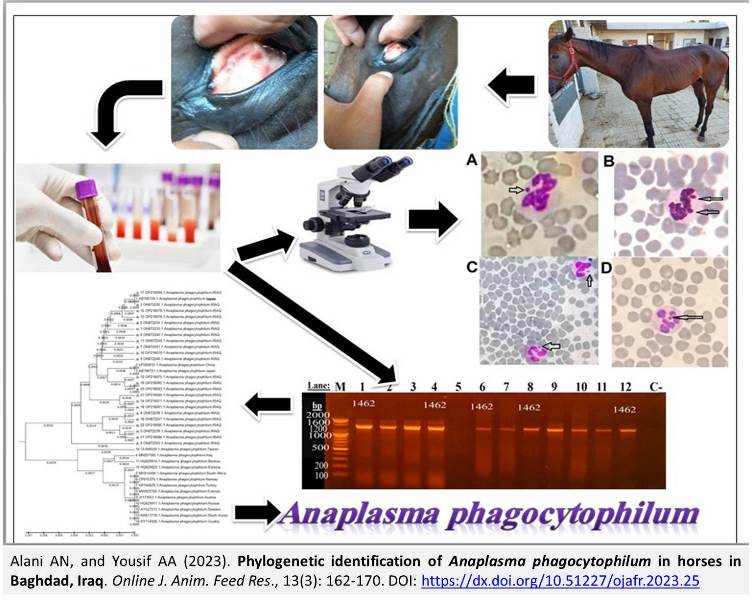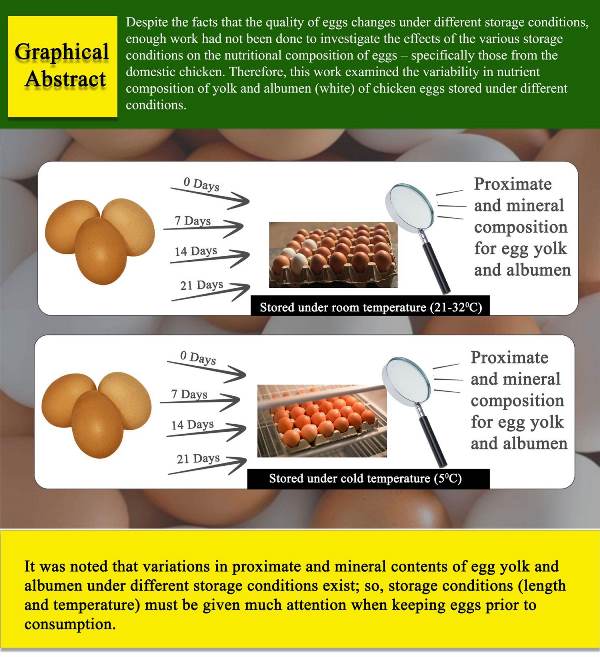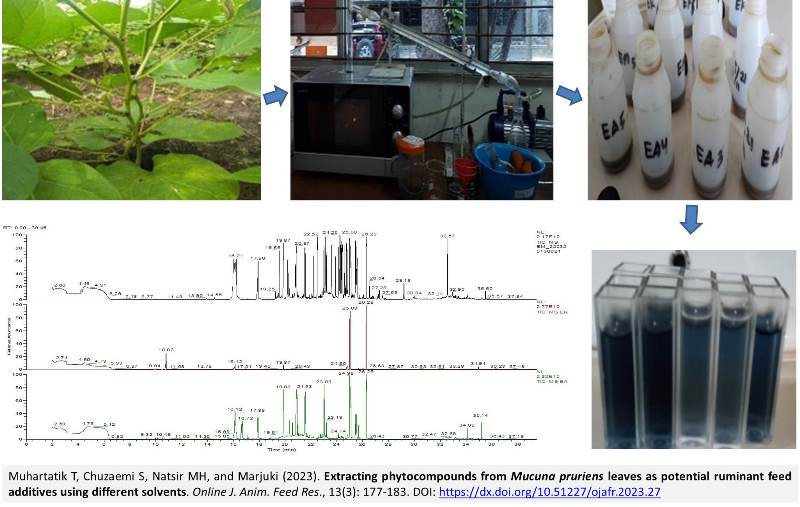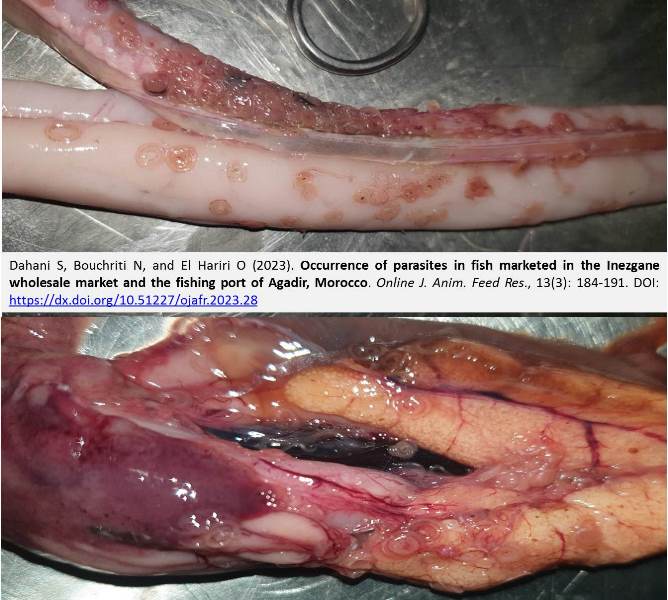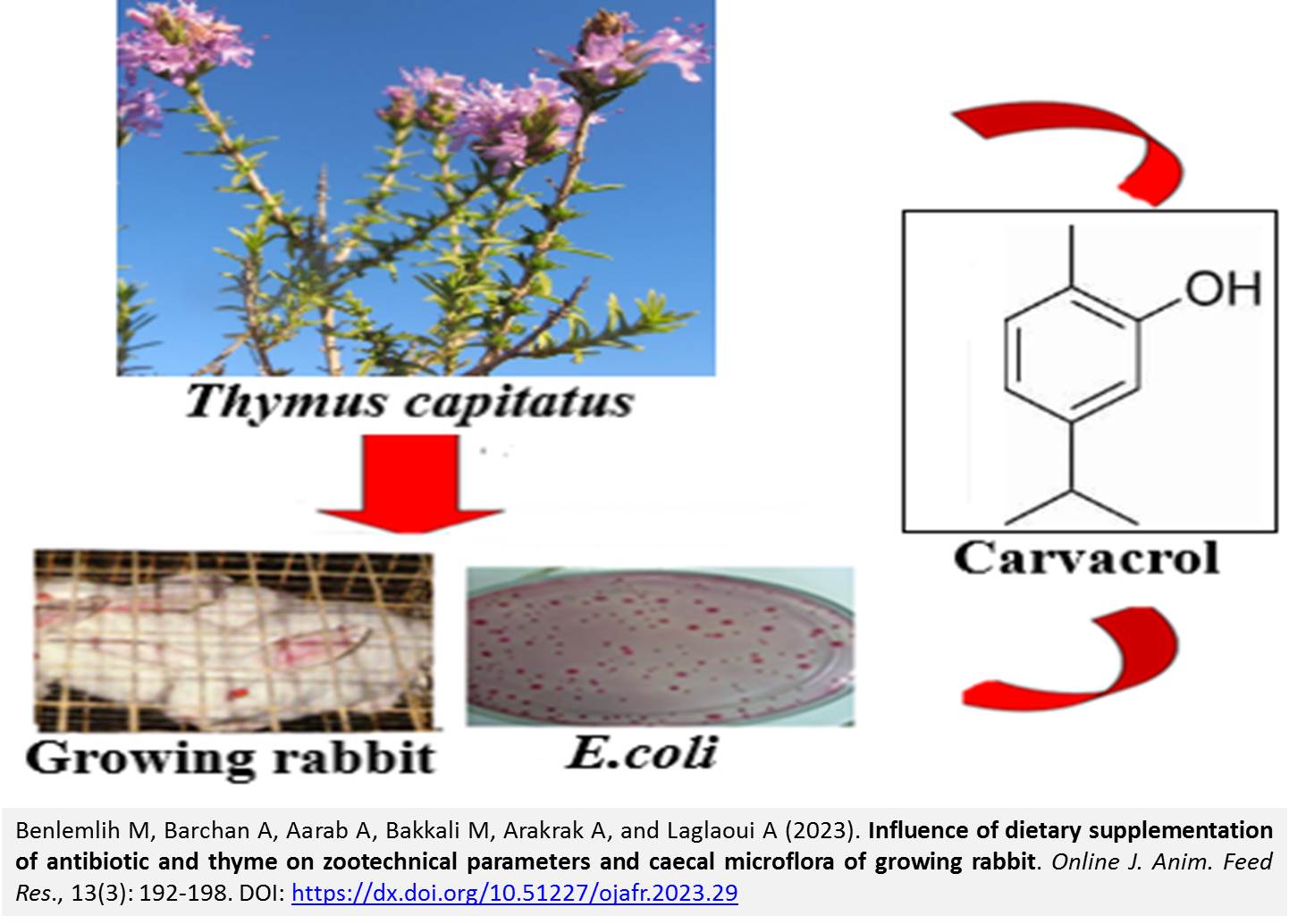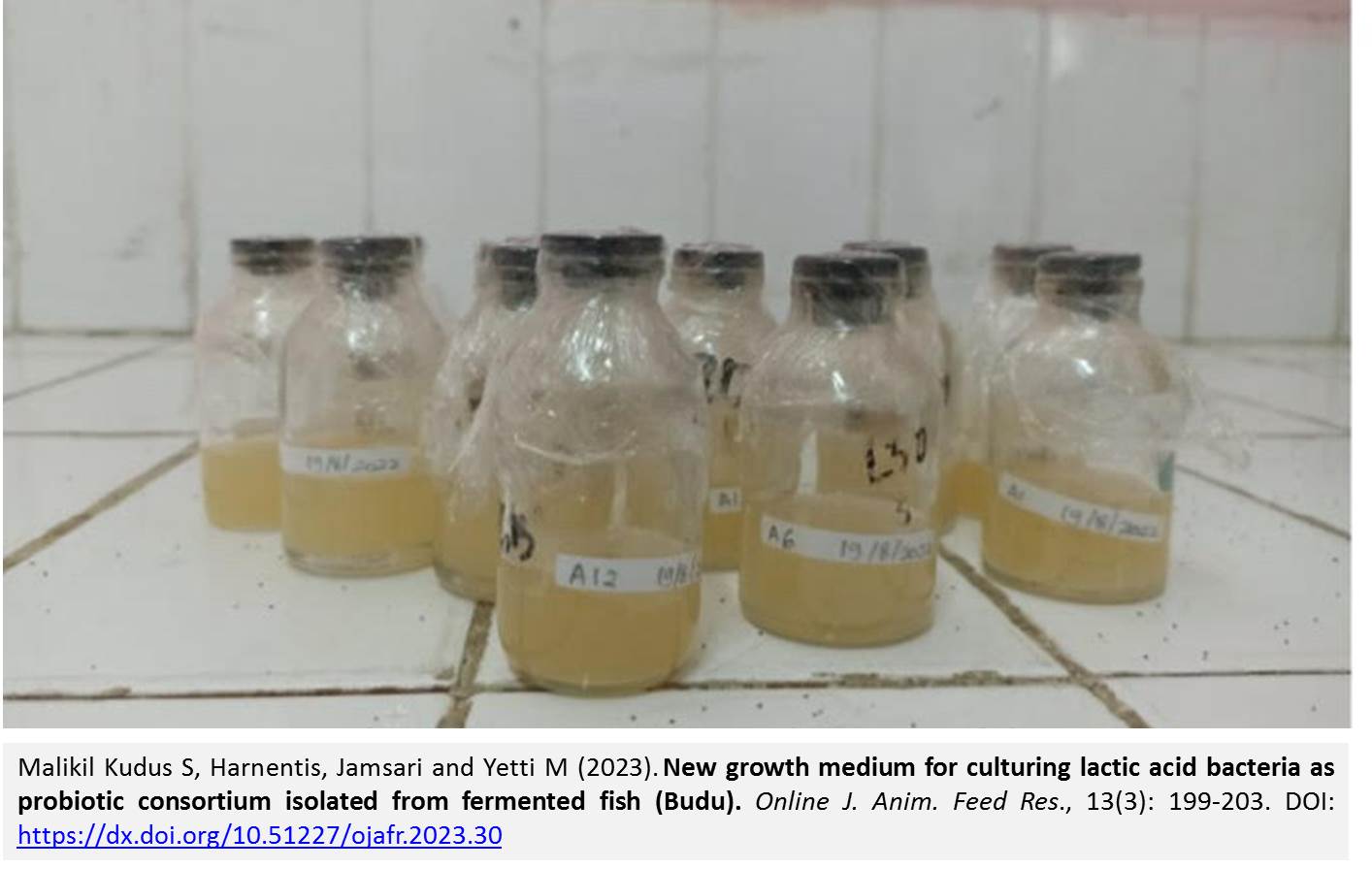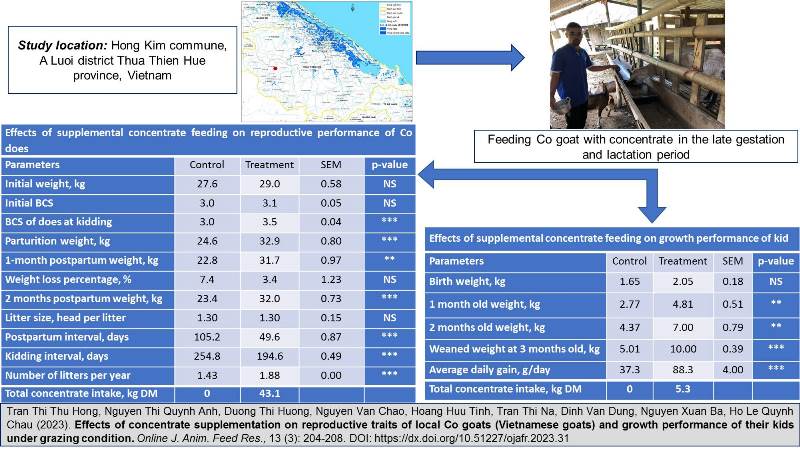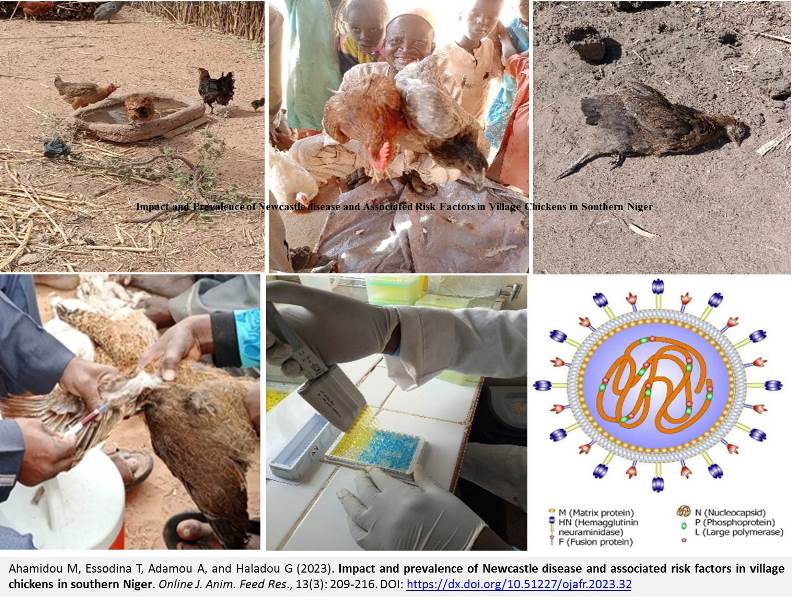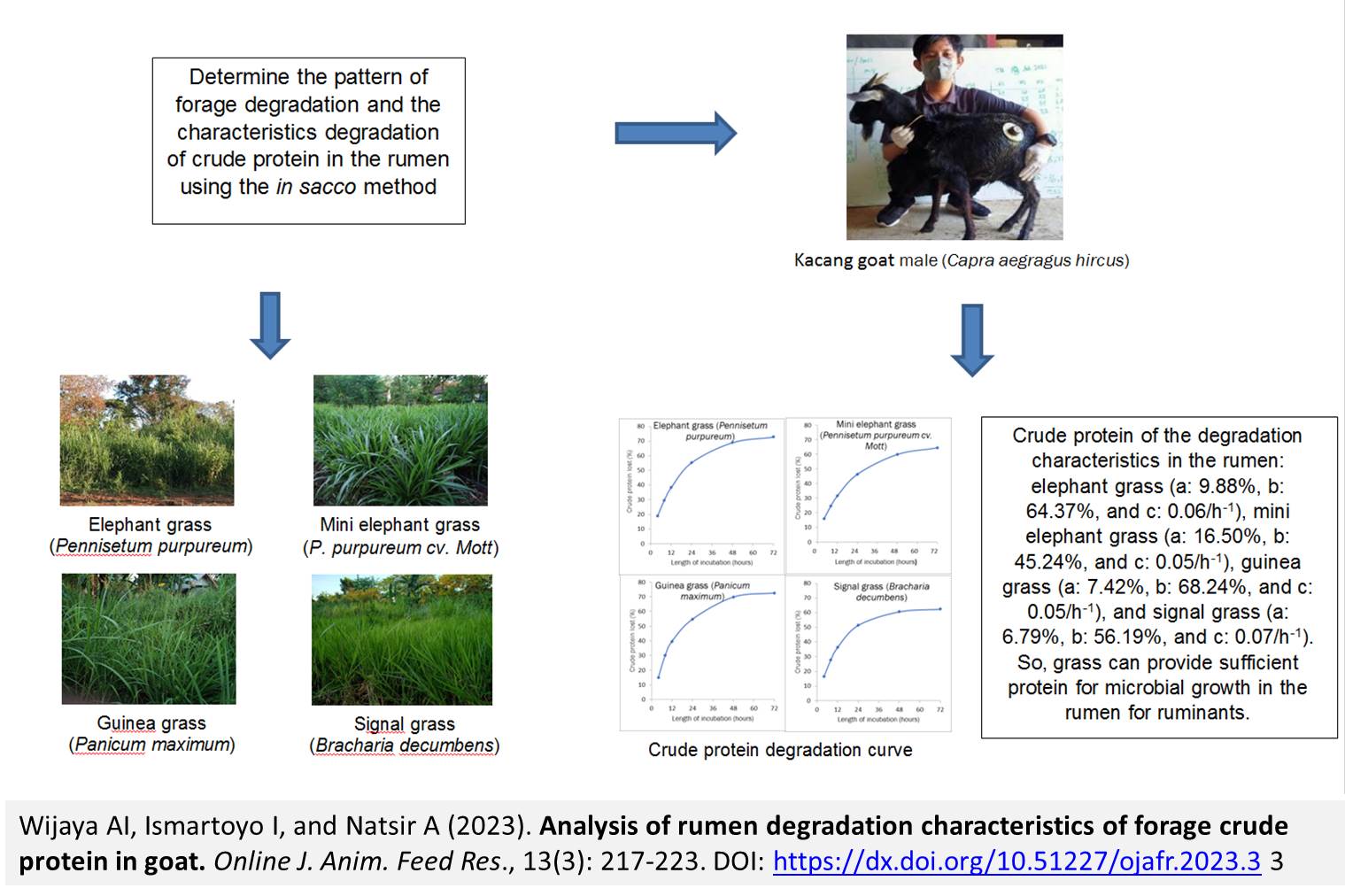Previous issue | Next issue | Archive
![]() Volume 13 (3); May 27, 2023 [Booklet] [EndNote XML for Agris]
Volume 13 (3); May 27, 2023 [Booklet] [EndNote XML for Agris]
Carcass characteristics and meat quality of crossbred (Brahman × Lai Sind) and (Red Angus × Lai Sind) bulls kept in small scale farms
Chi NTK, Hue PT, Hanh TQ and Ngoan LD.
Online J. Anim. Feed Res., 13(3): 153-161, 2023; pii: S222877012300024-13
DOI: https://dx.doi.org/10.51227/ojafr.2023.24
Abstract
This study aimed to evaluate carcass characteristics and meat quality of cross-bred (Brahman × Lai Sind, BL) bulls and cross-bred (Red Angus × Lai Sind, AL) bulls. A total of 30 bulls, 15 head/crossbred genotype were fattened for 90 days before slaughtering at 24 months of age. Carcass traits and meat quality were accordingly measured in 30 slaughtered animals. Results showed that the slaughter weight, carcass weight, carcass dressing, meat percentage, loin muscle area were higher for AL bulls than for BL bulls (p<0.05). The color of the meat was not affected by genotype with exception of L* at 48, 168 and 336 hours after slaughter, and this value was higher in AL than in BL bulls (p<0.05). The pH of the meat was not different between genotypes (p>0.05) but decreased quickly at 24 hours after slaughter (p<0.05), then maintained not significantly during storage times. The drip loss, cooking loss and tenderness of the meat were affected by cattle genotype and these values were lower in AL bulls than in BL bulls (p<0.05). In conclusion, crossbred (Red Angus × Lai Sind) bulls were higher carcass characteristics, and were better meat quality than crossbred (Brahman × Lai Sind) bulls.
Keywords: Brahman, Crossbred animals, Lai Sind cattle, Red Angus, Meat quality, Tenderness.
[Full text-PDF] [Scopus] [ePub] [Export from ePrints]
Phylogenetic identification of Anaplasma phagocytophilum in horses in Baghdad, Iraq
Alani AN, and Yousif AA.
Online J. Anim. Feed Res., 13(3): 162-170, 2023; pii: S222877012300025-13
DOI: https://dx.doi.org/10.51227/ojafr.2023.25
Abstract
This study aimed to detect Anaplasma phagocytophilum in horses through hematological and molecular tests. The 16S rRNA gene of the Anaplasma phagocytophilum parasite was amplified by polymerase chain reaction (PCR), then sequenced, and subjected to phylogenetic analysis to explore "Equine Granulocytic Anaplasmosis" (EGA) infection in three important gathering race horses areas in Baghdad governorate, Iraq. Blood samples were obtained from 160 horses of varying ages, three breeds, and both sexes, between January and December 2021. Prevalence and risk variables for anaplasmosis were analyzed using statistical odds ratio and chi-square tests. Results demonstrated that clinical anaplasmosis symptoms comprised jaundice, weight loss, paleness of mucus membrane with petechial hemorrhage in the third elides, and edema in extremities; There was no tick infestation. The hematological test did not significantly reveal decreases in red and white blood cells and platelet count. Microscopically found 11 from 160 smears (6.88%) had morulae within granulocytes, PCR results of Anaplasma spp primers was 32 positive amplicons (20%), and molecular sequencing results of “16S ribosomal RNA genes” confirmed 21 horses (13.13%) infected by Anaplasma phagocytophilum for the first time in Iraq horses. The results of the phylogenetic analysis revealed compatibility values similarity 98.81-99.76% with worldwide isolates. Mares occurred not significantly riskier; also age and breed were not illustrated risks of any group. This study is the first molecular detection of Anaplasma phagocytophilum in racehorses reared in Baghdad in Iraq. The outcomes of this study provide genetic data for early identification of Anaplasma phagocytophilum infection, treatment, and management of the illness in Iraq horses, as well as monitoring its transmission to the human population.
Keywords: Anaplasma phagocytophilum, Genetic, Mares, Phylogenetic analysis, Sequencing.
[Full text-PDF] [Scopus] [ePub] [Export from ePrints]
Research Paper
Variability in proximate and mineral compositions of yolk and albumen in eggs kept under different storage conditions
Kruenti F, Hagan JK, Ofori SA, and Lamptey VK.
Online J. Anim. Feed Res., 13(3): 171-176, 2023; pii: S222877012300026-13
DOI: https://dx.doi.org/10.51227/ojafr.2023.26
Abstract
This investigation evaluated the effects of storage length and temperature on the proximate and mineral compositions of yolk and albumen (white) of chicken eggs. A total of 720 eggs were used in a 4 X 2 factorial experiment consisting of four (0, 7, 14 and 21) storage days and two (room and cold) storage temperatures. Data obtained were subjected to ANOVA. The results showed no significant effect of storage length on crude protein and ash contents of the egg parts whereas carbohydrate increased significantly with increasing storage length. Also, protein and fat contents of the yolk were largely influenced (p<0.05) by storage temperature but nutrients in the albumen did not differ significantly between the two storage temperatures. On the other hand, mineral compositions of the egg components did not vary noticeably by storage temperature but storage length influenced some minerals considerably. It was noted that variations in proximate and mineral contents of egg yolk and albumen under different storage conditions exist; so, storage conditions (length and temperature) must be given much attention when keeping eggs prior to consumption in order to ensure nutrient quality.
Keywords: Egg quality, Egg protein, Nutrients, Storage length, Storage temperature.
[Full text-PDF] [Scopus] [ePub] [Export from ePrints]
Extracting phytocompounds from Mucuna pruriens leaves as potential ruminant feed additives using different solvents
Muhartatik T, Chuzaemi S, Natsir MH, and Marjuki.
Online J. Anim. Feed Res., 13(3): 177-183, 2023; pii: S222877012300027-13
DOI: https://dx.doi.org/10.51227/ojafr.2023.27
Abstract
Some secondary metabolites of plants could serve as ruminant feed additives. They primarily preserve protein from rumen breakdown, reduce rumen protozoa population, and decrease methane gas production. The current study aimed to identify the phytocompounds content of extracted Mucuna pruriens leaves using the Microwave-assisted extraction method using three different solvents of methanol 70% (EM), aquadest (EA), and combinations of EM and EA (EK). The phytocompounds were identified by Gas Chromatography-Mass Spectrometry (GC-MS) analysis. Some phytocompounds identified in the Mucuna pruriens substances from GC-MS curve proportion area of EM were 10.35% inositol, 3.1% quinazoline, 4.72% anthraquinone, 3.76% Coptisine, 2.06% isoquinoline, 2.18% D-gluconic acid, 2.83% D-Fructose, 3.91% D-glucose, and 4.59% butanedioic acid. The phytocompounds for EK were 17.22% inositol, 6.36% Niclosamide, 1.4% Acetamide, 1.32% Aniline, 55.97% 4-Amino-2-(4-methoxyphenyl)-5,6,7,8-tetrahydrofuro[2,3-b] quinoline-3-carbonitrile, 17.22% inositol. Furthermore, 22.73% inositol, 6.55%, ribonoic acid, 5.58%, silanol, 21.27% butanodioic acid, 2.88% Fluoroquinoxaline, 5,31%, glycerol, 1,64%, D- gluconic acid were found in the EA. The EA had high inositol content, the EK had high quinoline content, and the EM showed moderate results for all phytobiotics. The total phenolics, flavonoids, tannins, and saponins content significantly differed among the three solvents. The EA yielded the highest concentrations of total phenolics, flavonoids, and tannins, but the lowest concentration of total saponins. In contrast, the EM yielded the lowest total phenolics, flavonoids, and tannins content, but the highest total saponins content. Meanwhile, the EK yielded modest results for all phytocompounds, with values between EA and EM. In conclusion, the methanolic extract of Mucuna pruriens substance had the highest phytocompounds and bioactive potential as ruminant feed additives.
Keywords: Feed additives, Gas chromatography, Mucuna pruriens, Phytocompounds, Solvent, Secondary metabolites
[Full text-PDF] [Scopus] [ePub] [Export from ePrints]
Research Paper
Occurrence of parasites in fish marketed in the Inezgane wholesale market and the fishing port of Agadir, Morocco
Dahani S, Bouchriti N, and El Hariri O.
Online J. Anim. Feed Res., 13(3): 184-191, 2023; pii: S222877012300028-13
DOI: https://dx.doi.org/10.51227/ojafr.2023.28
Abstract
Based on importance of animal products safety, the purpose of this work was to assess the extent of parasitism at the wholesale market level of Inezgane and the fishing port of Agadir in Morocco. For this purpose, fieldwork aimed at direct investigation of parasites involved 366 fish pieces. This study was conducted in the period between March and June 2021. The prevalence of parasitism was 20.76%. The total number of parasites collected is 2385 including 1959 nematodes, 318 xenomas, 92 cestodes, and 16 isopods. An abundance of 6.51 and an overall intensity of 31.38. These infestation parameters varied by species and location of origin. For the qualitative analysis of the parasites, the study revealed a predominance of L3 larvae of the Anisakis nematode with a percentage of 82.14%. Xenomas had a percentage of 13.33%. As for the cestodes of Gymnorhynchus gigas, the larvae were collected from the Atlantic pomfret (Brama brama) with a percentage of 3.86%. As a result of this study, a significant positive correlation of r=0.81 was shown between the total length of the fish and the number of anisakids. The results of this study revealed that the extent of parasitism seems to be less pronounced in some species, but there is still a presence of concern.
Keywords: Anisakis, Fish, Fishing port, Parasitism, Wholesale market level
[Full text-PDF] [Scopus] [ePub] [Export from ePrints]
Influence of dietary supplementation of antibiotic and thyme on zootechnical parameters and caecal microflora of growing rabbit
Benlemlih M, Barchan A, Aarab A, Bakkali M, Arakrak A, and Laglaoui A.
Online J. Anim. Feed Res., 13(3): 192-198, 2023; pii: S222877012300029-13
DOI: https://dx.doi.org/10.51227/ojafr.2023.29
Abstract
The objective of this study was to compare the influence of antibiotic and thyme dietary supplements on zootechnical parameters and caecal microflora of growing rabbits. One hundred and ninety eight weaned rabbits (forty days old), white New Zealand (of both sexes) were divided into three groups to submit to the following dietary treatments: Control diet, diet A (control diet + 100 ppm zinc bacitracin), and diet T (control diet + 7% Thymus capitatus leaves) for twenty-one days. The remaining nine days they received only the control diet. The results showed that both the live body weight and feed conversion ratio were positively affected by the antibiotic diet (P<0.05). However, the rabbits' growth performance was not influenced by dietary thyme supplements. The antimicrobial effect of thyme observed against C. perfringens in caecum is not determined even after 20 days of treatment. In conclusion, zootechnical parameters and mortality were not positively affected by dietary thyme supplements comparing it with the antibiotic diet, but these phytobiotics showed the antibacterial effect against E. coli and C. perfringens in caecum of rabbit.
Keywords: Zinc bacitracin, Dietary supplementation, Growth performance, Rabbit, Thyme.
[Full text-PDF] [Scopus] [ePub] [Export from ePrints]
New growth medium for culturing lactic acid bacteria as probiotic consortium isolated from fermented fish (Budu)
Malikil Kudus S, Harnentis, Jamsari and Yetti M.
Online J. Anim. Feed Res., 13(3): 199-203, 2023; pii: S222877012300030-13
DOI: https://dx.doi.org/10.51227/ojafr.2023.30
Abstract
This study aimed to obtain the best ratio of inoculums and types of alternative media in increasing the growth of the probiotic consortium with the observed variables consisting of viability, cell biomass and decrease in pH. Completely randomized design (CRD) factorial consisting of 2 factors with 3 replications is used; factor A was the probiotic consortium (A1: Lactobacillus parabuchneri: L. buchneri: L. harbinensis, Schieferilactobacillus harbinensis and Lentilactobacillus parabuchner) with ratio 1:1:1:1:1; A2: same consortium with ratio 1:1:1:1:2; A3: same consortium with ratio 1:1:1:2:1; A4: same consortium with ratio 1:1:2:1:1; A5: same consortium with ratio 1:2:1:1:1; A6: same consortium with ratio 2:1:1:1:1 and factor B was the type of alternative media (B1=control; B2=coconut water (90%) + cassava flour (5%) + fish waste flour (5%); B3=tofu liquid waste (90%) + flour onggok (5%) + fish waste meal (5%); B4= tofu whey (90%) + onggok flour (5%) + fish waste meal (5%). The results showed that there was an interaction between factor A and factor B which was highly significant (P<0.01) on viability, cell biomass and decrease in medium pH. In conclusion, the best ratio of probiotic consortium was 1:1:1:2:1, with growth medium coconut water (90%) + cassava flour (5%) + fish waste flour (5%) which resulted in a viability value of: 3, 02, cell biomass: 22.47 mg/ml and a decrease in the pH of the medium by 2.84.
Keywords: Cell biomass, Fermentation, Medium pH, Probiotic consortium, Viability.
[Full text-PDF] [Scopus] [ePub] [Export from ePrints]
Effects of concentrate supplementation on reproductive traits of Co goats and growth performance of their kids under grazing condition
Tran HTT, Nguyen ATQ, Duong HT, Nguyen CV, Hoang TH, Tran NT, Dinh DV, Nguyen BX, and Ho CLQ.
Online J. Anim. Feed Res., 13(3): 204-208, 2023; pii: S222877012300031-13
DOI: https://dx.doi.org/10.51227/ojafr.2023.31
Abstract
The experiment was conducted in A Luoi district, Thua Thien Hue province of Vietnam, to evaluate the effect of concentrate supplementation on the reproductive traits of local Co goats and growth performance of their kids. A total of 20 pregnant Co goats in the last 1.5 month of pregnancy were monitored in two reproductive cycles. Goats were randomly divided into two dietary treatments as control (CG), in which animals freely grazed, and experiment (EG), in which concentrates were supplemented at 1.0% and 1.5% BW in the late gestation and lactation periods, respectively. After kidding, kids in each treatment were kept with their mother to access milk for the whole study period. In the CG, the kids have no supplements, and in the EG, the kids of 1 to 3 months of age were supplemented the concentrate at 1.5% BW/day. The results indicated that higher body condition scores and body weights of does after kidding, 1 and 2 months postpartum were in the EG than in the CG. The supplementation of concentrate also reduced the postpartum and kidding intervals; and increased the number of litters per year of does. Furthermore, the supplementation of concentrate improved significantly the weaning weight of kids and financial benefit per doe/per litter. In conclusion, the supplementation of concentrate in late pregnancy period and lactation diets improved reproductive traits of local Co goats and also concentrate supplementation in kids’ diet improved growth performance under grazing condition.
Keywords: Body condition score, Lactation, Local breeds, Pregnant, Small ruminants.
[Full text-PDF] [Scopus] [ePub] [Export from ePrints]
Impact and prevalence of Newcastle disease and associated risk factors in village chickens in southern Niger
Ahamidou M, Essodina T, Adamou A, and Haladou G.
Online J. Anim. Feed Res., 13(3): 209-216, 2023; pii: S222877012300032-13
DOI: https://dx.doi.org/10.51227/ojafr.2023.32
Abstract
The present study was conducted to determine the prevalence of Newcastle disease and to identify potential risk factors in village chickens in Niger. A total of 1,627 serum samples were collected using a stratified random sampling method with proportional allocation. Samples were collected from village breedings in the departments of the Maradi region (Guidan Roumdji, Madarounfa, Aguié, Gazaoua, and Tessaoua), departments of Zinder region (Takeita, Kantché, Magaria, Dungass, and Mirriah), and cities of Maradi and Zinder. Data on risk factors were collected through an interview with the herders. All collected sera were subjected to competitive enzyme-linked immunosorbent assay (cELISA) to detect Newcastle disease virus-induced antibodies. The findings were indicative of 302 positive sera, representing an overall seroprevalence of 18.6%. The Student’s t-test at p<0.05 revealed a significant difference between regions and among some departments. Furthermore, the logistic regression test identified the agroecological zone, type of breeding, species mix, and the origin of the animals as risk factors associated with seropositivity to Newcastle disease virus. The present results confirmed the exposure of village chickens to the Newcastle disease virus, emphasizing the need to intensify vaccination campaigns and educate poultry farmers on adopting biosecurity measures.
Keywords: Newcastle disease, Risk factors, Vaccination, Village chickens, Niger.
[Full text-PDF] [Scopus] [ePub] [Export from ePrints]
Analysis of rumen degradation characteristics of forage crude protein in goat
Wijaya AI, Ismartoyo I, and Natsir A.
Online J. Anim. Feed Res., 13(3): 217-223, 2023; pii: S222877012300033-13
DOI: https://dx.doi.org/10.51227/ojafr.2023.33
Abstract
The quality of feed given to ruminants can be determined from the degradation of nutrient content in the rumen. This study aimed to determine the pattern of forage degradation and the characteristics degradation of crude protein in the rumen using the in sacco method. The study used 4 fistulae kacang goats with an average body weight of 14.57 kg. The forage used consisted of R1: elephant grass (Pennisetum purpureum), R2: mini elephant grass (Pennisetum purpureum cv. Mott), R3: guinea grass (Panicum maximum), and R4: signal grass (Bracharia decumbens). The nylon bag is made of polyester measuring 8x4 cm with a porosity of 40 µm. Feed samples were put into the rumen and incubated for 0, 4, 8, 12, 24, 48, and 72 hours. The parameters measured were consumption, patterns, and forage degradation characteristics by calculating the values of a, b, c, a+b, lag time, and ED. Determination characteristics of feed degradation in the rumen by in sacco method will be analyzed. The results showed that the characteristics of crude protein degradation had significant differences in fraction values a, b, a+b, and lag time (P<0.05), while c and ED did not have significant differences (P>0.05). In conclusion the crude protein of the degradation characteristics in the rumen were: elephant grass (a: 9.88%, b: 64.37%, and c: 0.06/h-1), mini elephant grass (a: 16.50%, b: 45.24%, and c: 0.05/h-1), guinea grass (a: 7.42%, b: 68.24%, and c: 0.05/h-1), and signal grass (a: 6.79%, b: 56.19%, and c: 0.07/h-1). So, grass can provide sufficient protein for microbial growth in the rumen for ruminants.
Keywords: Crude protein, Degradability, Forage, in sacco, Rumen.
[Full text-PDF] [Scopus] [ePub] [Export from ePrints]
Previous issue | Next issue | Archive
This work is licensed under a Creative Commons Attribution 4.0 International License (CC BY 4.0).![]()
| < Prev | Next > |
|---|


